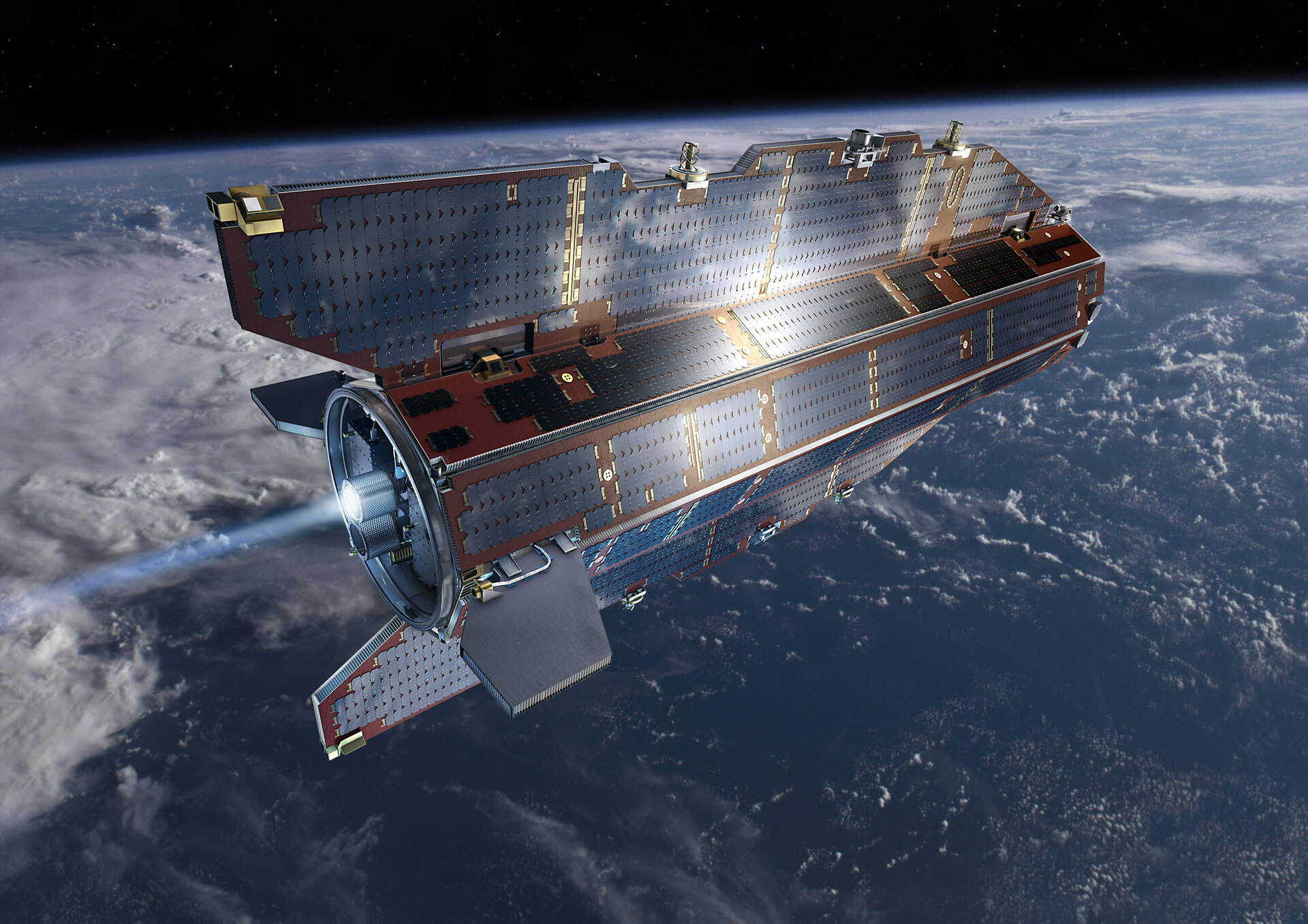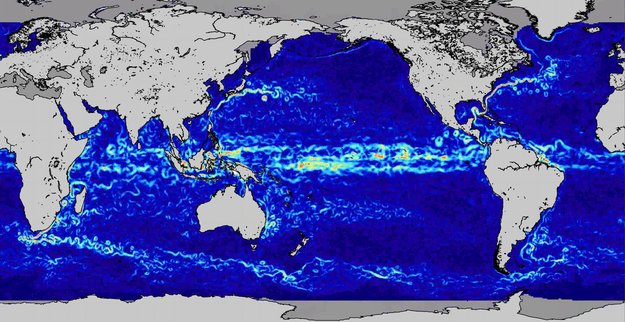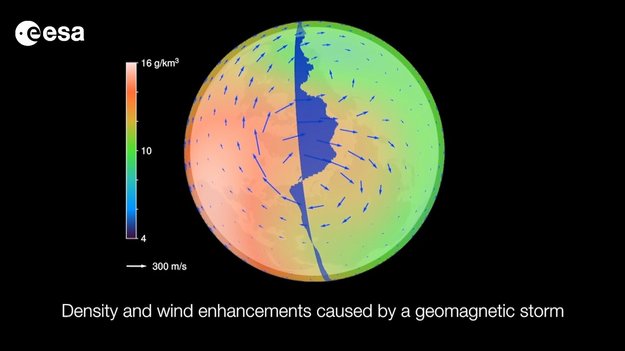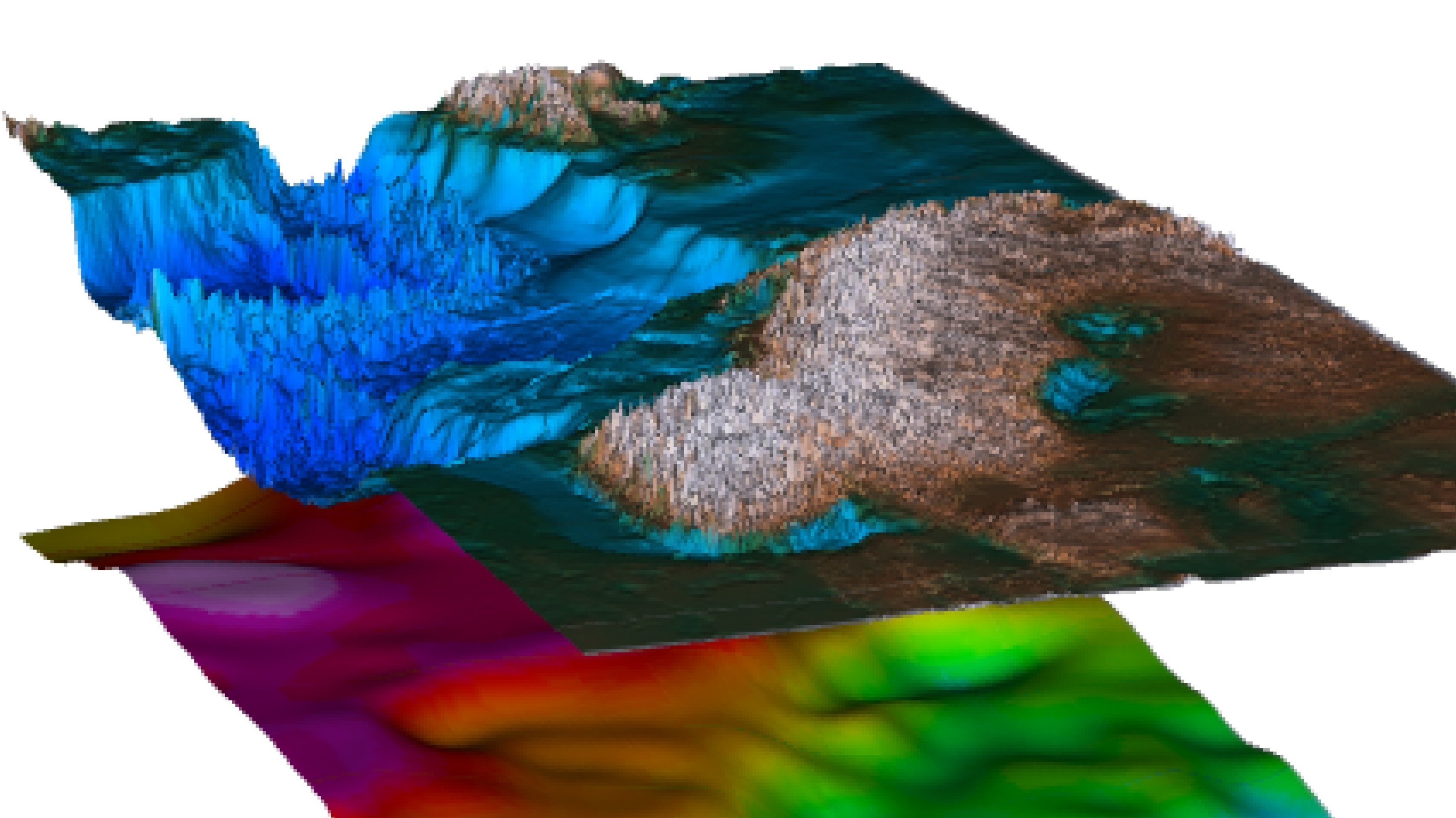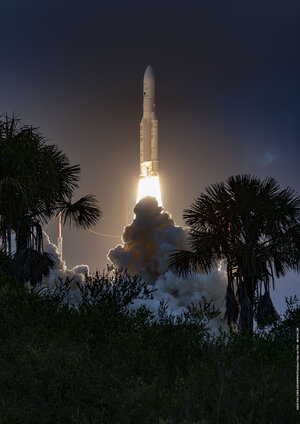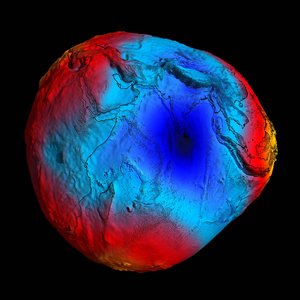GOCE completes its mission
After nearly tripling its planned lifetime, the Gravity field and steady-state Ocean Circulation Explorer – GOCE – has completed its mission and will soon reenter our atmosphere.
With a sleek, aerodynamic design responsible for it being dubbed the ‘Ferrari of space’, GOCE has mapped variations in Earth’s gravity with extreme detail. Scientists further exploited these data to create the first global high-resolution map of the boundary between Earth’s crust and mantle – called the Moho – and to detect sound waves from the massive earthquake that hit Japan on 11 March 2011, among other results.
In mid-October, the mission came to a natural end when it ran out of fuel and the satellite began its descent towards Earth from a height of about 224 km.
All of the latest information on the mission’s scientific results and reentry can be found here (all times in CET):
| 13 November 2013
|
| Final path of GOCE’s impact location reported by the US Joint Space Operations Center, combined with the impact ground swath that was estimated by ESA's Spacecraft Atmospheric Re-Entry and Aerothermal Break-up software. |
|
|
| 12 November 2013 |
| Data from GOCE’s final days will be used by the scientific community to learn more about atmospheric density and wind, and improve reentry modelling. “The fact that GOCE kept functioning so well for nearly the entire de-orbiting phase opens exciting new science opportunities,” said Rune Floberghagen, GOCE Mission Manager. “ESA will make sure all data relevant to the investigation of this phase are made readily available to the scientific community as soon as possible.” |
| |
| 12 November 2013 |
| A Falkland Islander managed to catch GOCE on camera as it disintegrated and burned in the atmosphere at about 01:20 CET yesterday. |
|
|
| 11 November 2013 - 12:05 |
| In close cooperation with NASA, ESA’s Space Debris Office confirms that atmospheric interface occurred at 01:16 CET this morning over the South Atlantic Ocean near the Falkland Islands, at an approximate altitude of 80 km. Fragments reached Earth’s surface over the southernmost regions of the South Atlantic. More information will be released as it becomes available. |
| |
| 11 November 2013 - 03:30 |
| Close to 01:00 CET on Monday, ESA’s GOCE satellite reentered Earth’s atmosphere on a descending orbit pass that extended across Siberia, the western Pacific Ocean, the eastern Indian Ocean and Antarctica. Read full article. |
|
|
| 11 November 2013 - 02:45 |
| The GOCE satellite has reentered the atmosphere. Details on where and when it landed will soon be communicated. |
|
|
| 11 November 2013 - 01:15 |
| Although GOCE operations are finished, ESA’s Space Debris Office is closely monitoring the satellite’s reentry. More information will be released as it becomes available. |
|
|
| 10 November 2013 - 23:50 |
| Contact with GOCE was made once again from the Troll station in Antarctica at 23:42 CET. The central computer temperature is at 80ºC and the battery is at 84ºC. At an altitude of less than 120 km, the spacecraft is – against expectations – still functional. |
|
|
| 10 November 2013 - 23:10 |
| On a short pass over the Troll ground station that ended at 21:18 CET, while GOCE flew at an altitude of only 122 km, the satellite was still showing amazing system performance and delivered highly valuable data to the ground station. Using these data, that included very accurate navigation fixes along its trajectory, an orbit could be fitted that was used to forecast the re-entry of the spacecraft. Current estimates lead to a reentry time window between 23:50 CET and 01:50 CET. The most probable reentry area lies on a descending orbit pass that mainly runs across the Pacific and the Indian Oceans. ESA will make another attempt to contact GOCE during a Troll station pass, to acquire more science and spacecraft data from an extremely low orbit altitude, and to further reduce the uncertainty in the re-entry forecast. |
| |
| 10 November 2013 - 22:35 |
| The spacecraft is still functioning nominally in Fine Pointing Mode, as seen in the last Troll pass made at 22:16 CET. The temperature of the central computer and battery is now around 64ºC, with some converters of the central computer already at 80ºC. The next possible visibility over Troll is expected at 23:42 CET. |
|
|
| 10 November 2013 - 21:20 |
| Contact was made nominally at 20:50 CET at Antarctica’s Troll station. The temperature of the central computer and battery is around 54ºC. Next visibility is expected again over Troll at 22:16 CET. Correction: Estimation for reentry of GOCE predicts a time window between 23:30 to 01:30 CET. |
| |
| 10 November 2013 - 20:15 |
| The spacecraft was seen again over Kiruna at 19:56 CET, at an altitude of about 126 km. Temperature of the central computer is now above 50ºC. Next contact is expected at KSAT's Troll station in Antarctica at 20:50 CET. |
|
|
| 10 November 2013 - 18:55 CET |
| GOCE is now below an altitude of 130 km. The spacecraft was still in good shape when last seen around 18:30 CET at ESA's Kiruna ground station in northern Sweden. Attitude control is working perfectly. Temperatures of the battery and central computer are now at about 45ºC. Next contact with GOCE is expected at Kiruna for around 20:00 CET. |
| |
| 10 November 2013 - 16:40 CET |
| Less than 10 hours before reentry, another ground contact was made with GOCE at 15:37 CET using KSAT's Svalbard station. The spacecraft is now at an altitude of just 133 km, with the decay rate around 1.5 km per hour. The Gradiometer has been switched off. GOCE’s scientific GPS receivers keep working very well. Temperatures close to the front of the spacecraft are increasing steadily: the central computer is now at around 40ºC. |
| |
| 10 November 2013 - 13:30 CET |
| ESA’s Space Debris Office says that reentry is expected to occur between 19:30 today and 01:00 tomorrow (CET). The most probable impact ground swath runs over oceans and polar regions. The probability of reentry over Europe can be excluded. With measurements from the Tracking and Imaging Radar, GOCE’s satellite-to-satellite tracking and orbit data from the Inter-Agency Space Debris Coordination Committee, the reentry of GOCE could be predicted with an accuracy of about +/-2 orbits. |
| |
| 10 November 2013 |
| Less than one day before the predicted reentry into the atmosphere, the spacecraft is still functioning well and standard spacecraft operations activities are proceeding. The satellite is at an altitude of about 147 km, dropping at a rate of more than 1 km an hour. Drag levels are now too high to be measured by the accelerometers. Based on the results of the orbit determination, average drag levels are at about 165 mN (milli Newton). Temperatures of units and subsystems close to the front of the spacecraft continue to increase, but have not yet reached levels threatening the correct functioning of GOCE. The orientation of the spacecraft is as it should be, with the attitude control system continuing to work well. Owing to its aerodynamic shape, it is estimated that the spacecraft is kept in the correct orientation by atmospheric drag forces alone. Given the fast altitude drop and change of environmental conditions, the end of flight operations is getting close. |
| |
| 9 November 2013 |
| This morning, GOCE was at an altitude of about 160 km. As expected, drag levels have increased with a current average of about 90 mN (milli Newton). There are significant temperature increases in several areas of the spacecraft, possibly linked to GOCE encountering increasingly dense atmosphere as its orbit drops. GOCE is expected to fall by over 13 km today. |
| |
| 8 November 2013 |
| Reentry of GOCE into Earth’s atmosphere is predicted to occur during the night between Sunday and Monday. Break-up of the spacecraft will occur at an altitude of approximately 80 km. At the moment, the exact time and location of where the fragments will land cannot be foreseen. The estimate is based on the results of detailed analysis, taking in to account a number of changeable factors including spacecraft orientation, the functioning of the attitude control system, as well as solar and geomagnetic activity. Updated predictions will be communicated on this page and in the related blog. |
| |
| 8 November 2013 |
| The satellite is at an altitude of about 170 km, with atmospheric drag levels at an average of over 50 mN (milli Newton). It is expected to drop a further 8 km during the day. The spacecraft continues to perform excellently at these extreme conditions, exceeding expectations. |
|
|
| 4 November 2013 |
| This morning, GOCE is at an altitude of roughly 192 km and is expected to drop by about 4 km during the day. The atmospheric drag and the resulting altitude decay rate are going to increase significantly over the coming days, as GOCE gets lower and lower. |
|
|
| 31 October 2013 |
| GOCE is now at an altitude of about 205 km, with atmospheric drag increasing with orbital decay. Rise in solar activity has also contributed to an increase in drag. On Sunday, at an altitude of roughly 195 km, the maximum drag for which GOCE's attitude control system has been validated is expected to be reached. |
|
|
| 28 October 2013
|
| Gravity data from GOCE are enabling other satellites to see ocean surface topography and currents. Gravity affects the shape of the ocean, creating large ‘bumps’ in places where gravity is high and pulling more water closer, or ‘dips’ where gravity is low. By subtracting GOCE’s gravity measurements from radar altimetry measurements, scientists have obtained a clearer view of an ocean shaped only by currents. |
|
|
| 24 October 2013 |
| Following depletion of fuel last Monday, GOCE's orbit has decayed by about 5.5 km. Today, the satellite is at an altitude of about 218.5 km. As expected at this early stage of the decay, drag levels are rather low and GOCE is behaving as expected. GOCE's attitude and orbit control system is now in its Fine Pointing Mode, the normal operational mode during orbital decay. |
|
|
| 23 October 2013
|
| GOCE thruster and accelerometer measurements have been used to create a brand new dataset of air density and wind speeds in the upper atmosphere. This new dataset also allows scientists to study interactions between the various layers of the atmosphere. |
|
|
| 21 October 2013 |
| GOCE’s end of mission was declared today when the fuel tank ran out of xenon. Data acquisition and satellite operations will continue for about two more weeks until its systems stop working because of the harsh environmental conditions at such a low altitude. At this point, the satellite will be switched off, marking the end of activities for the GOCE flight control team. The satellite is expected to reenter our atmosphere within the next three weeks. |
|
|
| 18 October 2013 |
| The pressure in GOCE’s fuel system has dropped below 2.5 bar, which is the pressure needed to fire the ion engine. It is estimated that there is about 350g of xenon left in the fuel tank. All eyes are now on the performance of the ion engine out of its nominal pressure range. If it functions until the tank is empty, orbital decay would start around 26 October. However, controllers expect the ion engine to terminate well before that. |
|
|
| 14 October 2013 |
| The Spacecraft Operations Manager estimates that GOCE will run out of fuel after the end of this week. The xenon tank pressure is now below 5 bar – ion propulsion is expected to stop after pressure drops below 2.5 bar (foreseen on 19 October). |
|
|
| 7 October 2013 |
| Spacecraft Operations Manager gives overview of what to expect during GOCE’s final weeks. |
|
|
| 13 September 2013 |
| ESA’s GOCE mission to end this year and begin its descent towards Earth in the weeks following. While most of GOCE will disintegrate in the atmosphere, several parts might reach Earth’s surface. |
|
|
| 10 September 2013
|
| Data acquired at GOCE’s super-low orbit sheds new light on Earth’s interior. Geophysicists are using GOCE gravity gradient measurements to gain new insights into the geodynamics associated with the lithosphere. |
|
|
| 30 May 2013 |
| GOCE’s orbit lowered even further to about 224 km. A lower orbit means a stronger atmospheric drag pulls the satellite towards Earth. But GOCE was designed to fly low, so the tiny thrust of its ion engine continuously compensate for any drag. |
|
|
| 8 March 2013
|
| Scientists find that GOCE detected sound waves from the massive earthquake that hit Japan on 11 March 2011. When the satellite passed through these waves, its accelerometers sensed the vertical displacements of the surrounding atmosphere. |
|
|
| 15 February 2013 |
| Slope of sea debate settled by GOCE. |
|
|
| 15 February 2013 |
| GOCE lowered to 235 km. Lowering the orbit increases the accuracy and resolution of GOCE’s measurements, improving our view of smaller ocean dynamics such as eddy currents. |
|
|
| Archived articles |















 Germany
Germany
 Austria
Austria
 Belgium
Belgium
 Denmark
Denmark
 Spain
Spain
 Estonia
Estonia
 Finland
Finland
 France
France
 Greece
Greece
 Hungary
Hungary
 Ireland
Ireland
 Italy
Italy
 Luxembourg
Luxembourg
 Norway
Norway
 The Netherlands
The Netherlands
 Poland
Poland
 Portugal
Portugal
 Czechia
Czechia
 Romania
Romania
 United Kingdom
United Kingdom
 Slovenia
Slovenia
 Sweden
Sweden
 Switzerland
Switzerland


























